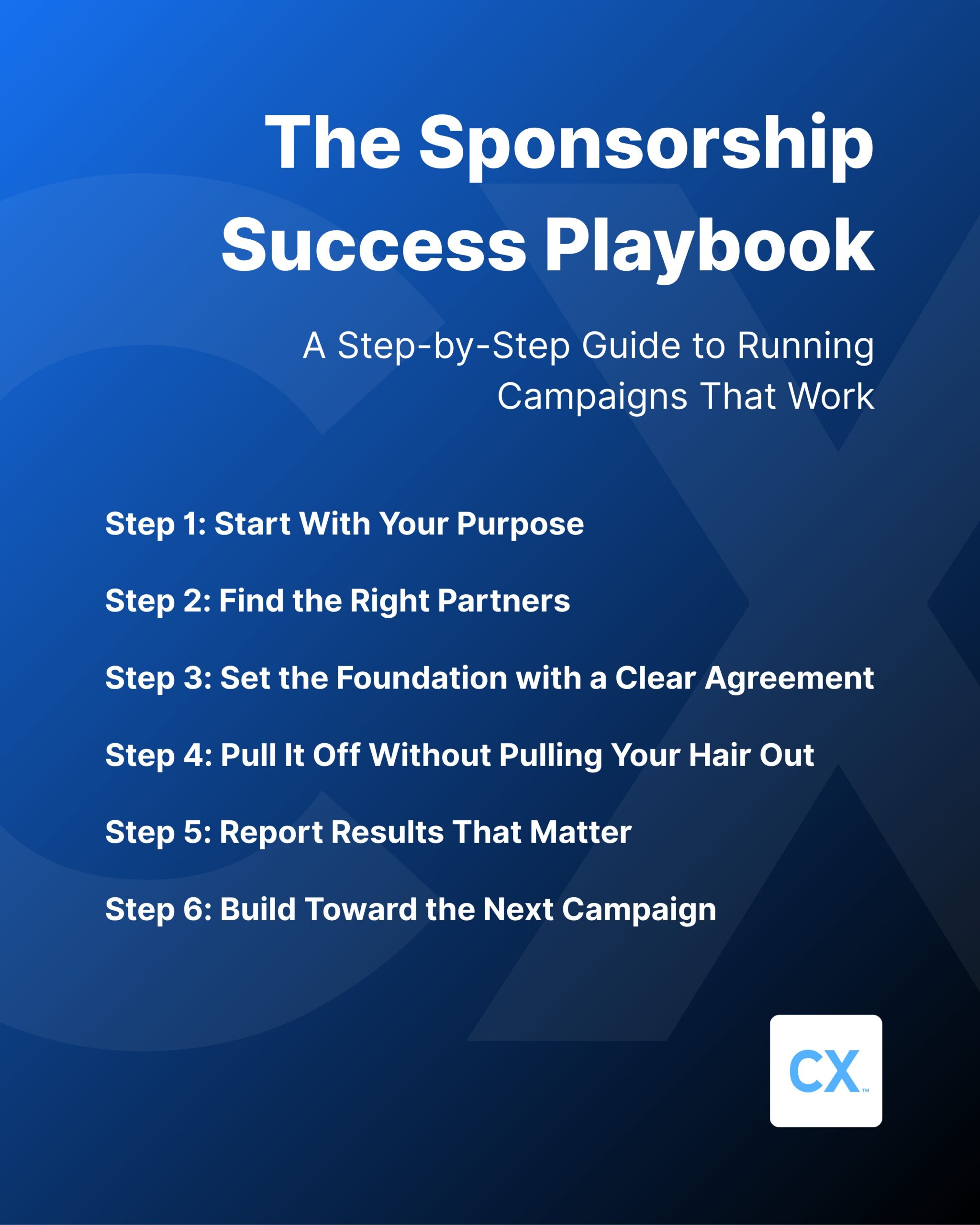The Sponsorship Success Playbook
A Step-by-Step Guide to Running Campaigns That Work
The email hit the marketing manager’s inbox on a Tuesday morning. “Exciting Sponsorship Opportunity!” was the subject line.
By lunch, the brand’s marketing team was huddled in a conference room, half-curious, half-skeptical. The event looked like a fit. The audience aligned. The pitch deck had glossy illustrations, infographics, and impressive stats. But what to do next was anybody’s guess.
“What do we even ask them?” someone muttered.
“Can we track ROI?” another asked.
“Do we have budget for this, or even time to manage it?”
All fair questions. A lot of marketing teams don’t have answers. Most brands like the idea of sponsorships. But turning them into strategic, well-run campaigns? That’s where things get complicated.
This sponsorship guide answers those questions with a clear, step-by-step playbook—from first outreach to final report. No guesswork. No inbox chaos. Just a better way to run sponsorships that work.
Why Brands Need a Better Sponsorship Success Guide
Lots of sponsorships look great on paper but when it comes time for execution, things fall apart. Without structure, assets get missed, timelines slip, and no one’s sure if it even worked. That’s a waste of budget and trust.
This sponsorship guide is for those that want more than logo placement. It’s for teams ready to build real partnerships that drive results, not just impressions.
Here’s what you’ll find:
- A step-by-step process from outreach to reports
- How to run a sponsorship campaign with less chaos
- Clear, useful actions– no fluff, no jargon
What you won’t find is vague theory or marketing speak that doesn’t help. Let’s get started.

Step 1: Start With Your Purpose
Before you jump into outreach or begin eyeing media kits, pause and ask: What does success look like for us? Brands want more than visibility. They want meaning. They want purpose-driven sponsorships.
- Define Success. Are you after brand lift? Sales leads? Audience engagement. Pick a lane but don’t try to drive in all of them.
- Identify your audience(s). Do you know who you want to reach? What channels will reach them? Social? On-site activations? Content collabs? Know that before you pick partners.
- Find the right fit. Choose properties that reflect your brand’s voice and values. A good match builds trust. A bad one does more damage than good.
This first step affects everything that comes after in your sponsorship success guide. Skip it, and the rest gets harder. Nail it, and you’re off to a clean start.

Step 2: Find the Right Partners
Not all sponsorships are worth chasing. Some will fit like a glove, others can be like a nightmare blind date.
- Look for audience alignment. Does the opportunity reach your ideal customer? Do you share values, tone and storytelling potential?
- Evaluate the proposal. Look past the sizzle. Ask how the partner will deliver, what data they’ll share, and how flexible they are. Watch for vague promises, bloated pricing, or one-size-fits-all packages.
- Walk away when it doesn’t feel right. If something feels off now, trust your gut. Sponsorships don’t magically get better after the contract is signed.
Choosing the right partners early on saves time and protects your budget and your brand. It’s the pillar on which the sponsorship campaign lifecycle depends.
Step 3 – Set the Foundation with a Clear Agreement
A handshake and optimism aren’t enough. If you want a campaign that delivers desired results, you need more than mutual enthusiasm. You need structure. A clear, concise agreement provides everyone a roadmap. It’s indispensable in any sponsorship guide.
- Define deliverables, assets and timeline. Get specific. What exactly are you paying for—logo placements, social media posts, event appearances, branded content? Spell it all out. Include clear deadlines and leave no room for assumptions or vague promises.
- Assign roles and deadlines. Who owns what? When is it due? Set responsibilities on both sides and build in checkpoints to track progress. Missed deadlines often come from unclear ownership, not bad intentions.
- Use software, not spreadsheets. Sponsorships involve a lot of moving parts—files, approvals, deadlines, performance metrics. Trying to manage all that in Excel is asking for trouble. This is where sponsorship management software shines. It gives your team a centralized hub for tracking every detail, keeping everyone aligned and accountable. But not all platforms are equal. Be selective when choosing.
A clear agreement doesn’t just protect your budget—it’s the backbone of a smart sponsorship execution strategy. Miss this step, and you’re inviting missed deadlines, confusion, and frustration. Get it right and you’re on the way to a clean, well-run campaign.
Step 4 – Pull It Off Without Pulling Your Hair Out
Execution is where most sponsorships start to wobble. The deal’s signed, everyone’s excited, and then the real work begins. Pulling it off without pulling your hair out comes down to structure, communication, and follow-through. Here’s how to keep the campaign rolling smoothly:
- Meet deadlines. Missed assets mean missed impressions. Set clear deadlines, and use tools (not sticky notes) to track what’s due and when.
- Watch what’s working. Don’t wait until it’s over to find out something flopped. Keep a pulse on audience engagement, impressions, clicks—whatever you’re measuring. Adjust mid-flight if needed.
- Hold your partner accountable. It’s a two-way street. You’re a partner, not a passive buyer. Check in, ask questions, and make sure no one drops the ball.
The best campaigns run like clockwork because someone set the clock and keeps it running
Step 5 – Report Results That Matter
The campaign’s over. Now it’s time to answer, Did it work? Here’s how to report results in a way that earns trust and renewals:
- Skip the fluff. Big reach numbers don’t tell the full story. Clicks, conversions and brand lift tell the real story. Look at all your KPI’s to measure real impact.
- Show the data clearly. Don’t bury the story in spreadsheets. Use dashboards, charts, graphs, and visuals. They help your team and leadership instantly see what worked (and what didn’t).
- Tie results back to goals. Remember Step 1? Revisit those goals and show how the sponsorship delivered—or didn’t. Either way, you’re building credibility and setting the stage for smarter campaigns going forward.
Reporting isn’t about showing off. It’s about owning results and learning what to do better next time. That’s smart sponsorship ROI reporting.

Step 6 – Build Toward the Next Campaign
The best sponsorships aren’t one-and-done. They get better over time. But that only happens when you look back before moving forward. Understanding the sponsorship campaign lifecycle is vital. Here’s how to wrap your campaign in a way that sets you up for better decisions and better results next time:
- Debrief with everyone. Sit down with all your partners while it’s still fresh. What worked? What felt clunky? Get honest feedback from both sides. This isn’t just a formality—it’s how you build stronger working relationships.
- Document what to change. Don’t rely on memory. Were deadlines realistic? Did approvals happen on time and without hassle? Capture it now so you’re not repeating avoidable mistakes.
- Know when to renew or move on. Not every partnership deserves a sequel. If it didn’t deliver, move on. But if it worked, and you have the data to prove it, it’s worth exploring what’s next.
Good sponsorships are built over time. Strong relationships and smart adjustments are how you create mutually beneficial value. This is a key part of any solid sponsorship retention strategy and where long-term ROI really starts to show.
The Benefits of Sponsorship Management Platforms
Here’s what the right sponsorship management software can do for your team:
- Everything lives in one place—no more chasing logos through email threads
- Automate routine tasks like reminders, asset requests, and deadline alerts
- Track deliverables and approvals without sticky notes or spreadsheets
- Give your team real-time visibility so no one’s left guessing
- Gaps are spotted in your execution before they become headaches
- Make reporting easier with built-in dashboards and exportable data
- Save time, reduce stress, and impress leadership with your competence
Automation isn’t just nice—it’s how busy teams stay focused on strategy instead of chasing checkboxes.
The Bottom Line
Great sponsorships don’t happen by chance. Great sponsorships happen when you follow a clear process, keep communication open, and stay focused on outcomes.
When your team is juggling campaigns, deadlines, and partners, end-to-end sponsorship management make all the difference. Spreadsheets create chaos. Sponsorship management platforms like SponsorCX bring control.
You already have the ambition. The audience. The opportunity to build partnerships that matter.
SponsorCX is here to help you do it. You’re the hero in your story. We’re an experienced guide that can help you cut through clutter, stay on track, and deliver results. From outreach to wrap-up, we’re on your side.
Let’s get started.











